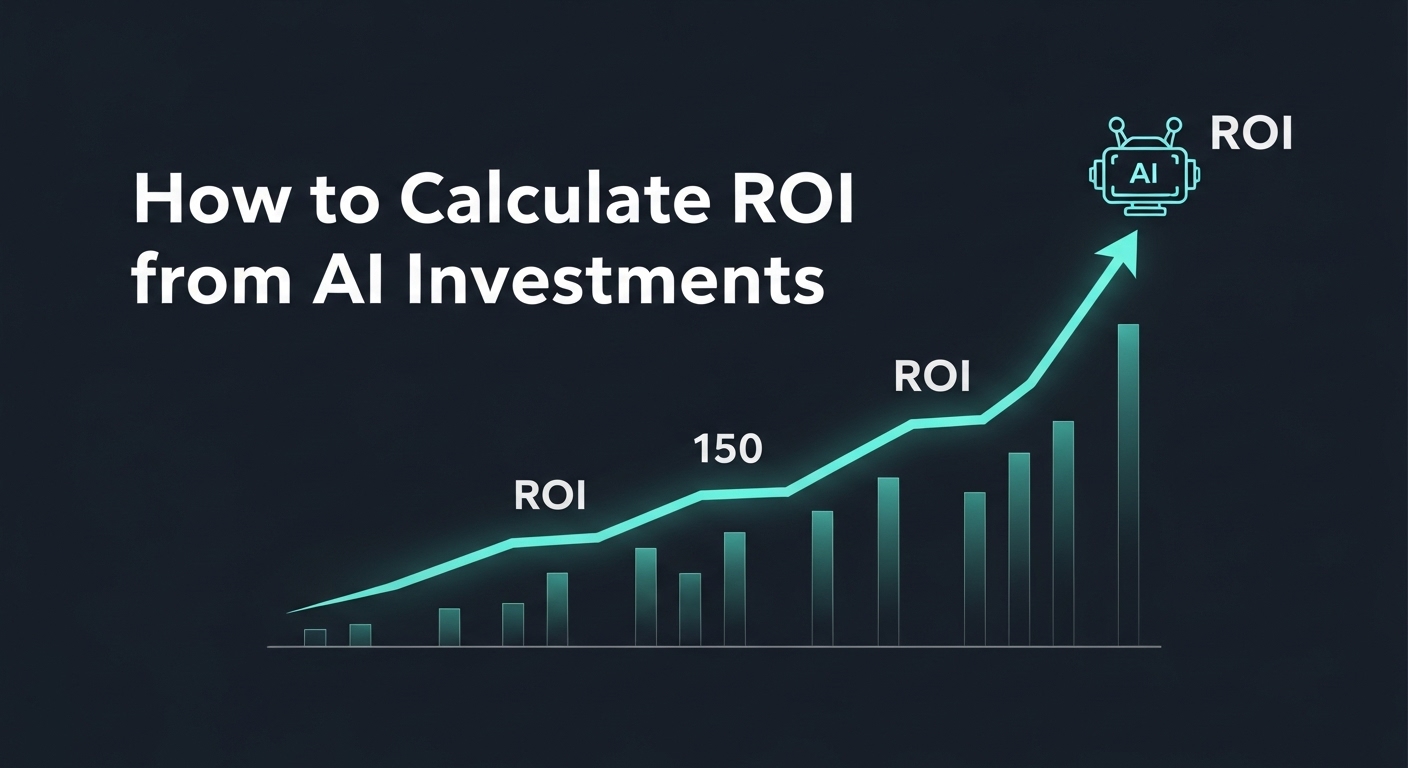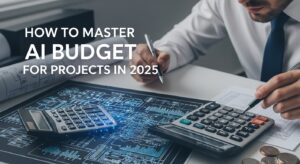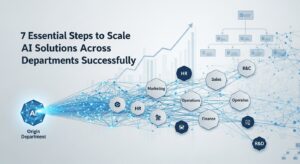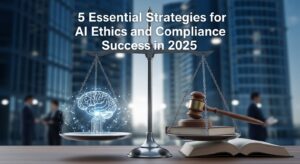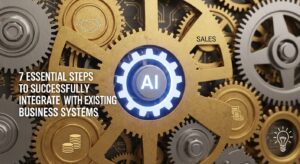When organizations invest millions in artificial intelligence initiatives, one question dominates boardroom discussions: “What’s our return on investment?” Understanding how to calculate ROI from AI investments has become crucial as AI spending reaches unprecedented levels, with global AI investment expected to exceed $500 billion by 2025.
Yet many executives struggle with AI ROI calculation because traditional metrics often fall short when measuring transformative technologies. Unlike conventional software implementations, AI investments frequently deliver benefits that extend beyond immediate cost savings into areas like improved decision-making, enhanced customer experiences, and competitive advantages that are harder to quantify.
This comprehensive guide will equip you with practical frameworks, proven formulas, and real-world strategies to accurately measure and optimize your AI investment returns.
Understanding the Fundamentals: What Makes AI ROI Different
Before diving into calculation methods, it’s essential to understand why AI investment ROI differs from traditional technology investments. AI systems often provide compound value that grows over time, making initial ROI calculations appear modest while long-term benefits prove transformational.
Traditional ROI calculations focus on direct cost savings and revenue increases. AI investments, however, generate value through multiple channels:
- Direct Financial Benefits include labor cost reduction, operational efficiency gains, and revenue increases from new products or services. These tangible benefits are easiest to measure and often form the foundation of initial ROI calculations.
- Indirect Benefits encompass improved decision-making speed, reduced errors, enhanced customer satisfaction, and competitive positioning. While harder to quantify, these benefits often exceed direct savings in long-term value creation.
- Strategic Value includes market positioning, data asset development, and organizational learning that enables future innovations. This category represents the most challenging aspect of AI ROI measurement but often delivers the highest returns.
The Complete Framework: How to Calculate ROI from AI Investments
Basic ROI Formula for AI Projects
The fundamental formula for calculating ROI from AI investments adapts the traditional ROI calculation with AI-specific considerations:
AI ROI = (Total Benefits - Total Costs) / Total Costs × 100
However, this basic formula requires careful definition of both benefits and costs in the AI context.
Total Costs should include:
- Initial development and implementation expenses
- Hardware and software infrastructure
- Training and change management
- Ongoing maintenance and updates
- Data preparation and management
- Compliance and security measures
Total Benefits encompass:
- Direct cost savings from automation
- Revenue increases from new capabilities
- Efficiency gains and productivity improvements
- Quality improvements and error reduction
- Customer satisfaction and retention improvements
- Risk mitigation and compliance benefits
Advanced ROI Calculation Methods
1. Net Present Value (NPV) Approach
For long-term AI investments, NPV provides a more accurate picture by accounting for the time value of money:
NPV = Σ (Cash Flow / (1 + Discount Rate)^Year) - Initial Investment
This method proves particularly valuable for AI projects with extended implementation timelines and evolving benefits.
2. Payback Period Analysis
Calculate how quickly your AI investment will recover its costs:
Payback Period = Initial Investment / Annual Cash Flow from AI
Most successful AI implementations achieve payback within 18-24 months, though transformational projects may require longer horizons.
3. Total Economic Impact (TEI) Model
This comprehensive approach, popularized by Forrester Research, examines:
- Direct benefits and cost savings
- Indirect benefits and productivity gains
- Risk mitigation value
- Implementation costs and ongoing expenses
Real-World ROI Calculation Examples
Case Study 1: Manufacturing Predictive Maintenance
A manufacturing company implemented AI-powered predictive maintenance with the following metrics:
Investment Costs:
- Software licensing: $200,000
- Implementation services: $150,000
- Training and change management: $75,000
- Total Investment: $425,000
Annual Benefits:
- Reduced unplanned downtime: $800,000
- Lower maintenance costs: $300,000
- Extended equipment lifespan: $200,000
- Total Annual Benefits: $1,300,000
ROI Calculation:
ROI = ($1,300,000 - $425,000) / $425,000 × 100 = 206%
This example demonstrates how AI investment ROI can exceed 200% when properly implemented in operational environments.
Case Study 2: Customer Service Automation
A financial services firm deployed AI chatbots and achieved:
Implementation Costs:
- Platform development: $300,000
- Integration and testing: $100,000
- Staff training: $50,000
- Total Investment: $450,000
Annual Benefits:
- Reduced agent costs: $600,000
- Improved resolution speed: $200,000
- Enhanced customer satisfaction: $150,000
- Total Annual Benefits: $950,000
ROI Calculation:
ROI = ($950,000 - $450,000) / $450,000 × 100 = 111%
Key Metrics for Measuring AI Investment Success
Operational Efficiency Metrics
Track specific performance indicators that demonstrate AI impact:
- Productivity Metrics measure output per employee, processing speed improvements, and automation rates. These quantifiable metrics provide clear evidence of operational enhancements.
- Quality Metrics include error reduction rates, accuracy improvements, and compliance adherence. AI systems often deliver significant value through quality enhancements that reduce rework and customer complaints.
- Speed Metrics encompass processing time reductions, decision-making acceleration, and response time improvements. Faster operations translate directly into competitive advantages and customer satisfaction gains.
Financial Performance Indicators
Monitor financial metrics that directly correlate with AI implementation:
- Revenue Growth from new AI-enabled products, services, or capabilities. Track incremental revenue attributable to AI features or enhanced offerings.
- Cost Reduction across labor, materials, energy, and overhead categories. Document specific savings linked to AI automation and optimization.
- Profit Margin Improvements resulting from both revenue increases and cost reductions. AI investments often improve margins through multiple simultaneous impacts.
Common Challenges in AI ROI Measurement
Attribution Complexity
Determining which benefits specifically result from AI versus other concurrent initiatives poses significant challenges. Establish clear baselines before AI implementation and use control groups where possible to isolate AI impact.
Intangible Benefits Quantification
Many AI benefits resist easy quantification. Develop proxy metrics for intangible benefits like improved employee satisfaction, enhanced brand reputation, or better strategic positioning.
Customer satisfaction improvements, for instance, can be measured through retention rates, Net Promoter Scores, and lifetime value calculations. Employee productivity gains might be tracked through output metrics, error rates, and time-to-completion measurements.
Long-Term Value Recognition
AI systems often improve over time through machine learning and expanded use cases. Initial ROI calculations may underestimate long-term value creation, requiring ongoing measurement and adjustment.
Best Practices for Maximizing AI Investment Returns
Strategic Implementation Approach
- Start with High-Impact Use Cases that offer clear, measurable benefits. Focus initial AI investments on processes with well-defined inputs, outputs, and success metrics.
- Ensure Data Quality before implementation. Poor data quality represents the primary cause of AI project failures and significantly impacts ROI potential.
- Plan for Scale from the beginning. AI solutions often achieve better ROI when deployed across multiple departments or use cases rather than isolated applications.
Measurement and Optimization
- Establish Clear Baselines before AI implementation to enable accurate before-and-after comparisons. Document current performance levels across relevant metrics.
- Implement Continuous Monitoring to track AI performance and identify optimization opportunities. Regular assessment enables proactive adjustments that maintain or improve ROI.
- Conduct Regular Reviews to assess whether AI investments are meeting expected returns and identify areas for improvement or expansion.
Industry-Specific ROI Benchmarks
Healthcare AI Investments
Healthcare organizations typically see AI investment ROI ranging from 150-300% within two years, primarily through:
- Diagnostic accuracy improvements
- Administrative cost reductions
- Treatment optimization
- Reduced readmission rates
Retail and E-commerce
Retail AI implementations often achieve 200-400% ROI through:
- Personalization and recommendation engines
- Inventory optimization
- Dynamic pricing strategies
- Supply chain improvements
Financial Services
Financial institutions frequently report 180-250% ROI from AI investments in:
- Fraud detection and prevention
- Risk assessment automation
- Customer service enhancement
- Algorithmic trading optimization
Advanced ROI Analysis Techniques
Scenario-Based Modeling
Develop multiple ROI scenarios based on different adoption rates and performance levels. This approach helps stakeholders understand potential ranges rather than single-point estimates.
- Conservative Scenario: Minimum expected benefits with standard implementation
- Realistic Scenario: Most likely outcomes based on industry benchmarks
- Optimistic Scenario: Maximum potential benefits with exceptional execution
Sensitivity Analysis
Examine how changes in key variables affect ROI calculations. This analysis helps identify the most critical success factors and risk mitigation priorities.
Test sensitivity to factors like:
- Implementation timeline variations
- User adoption rates
- Performance improvement levels
- Cost overrun scenarios
Tools and Technologies for ROI Tracking
AI-Specific Analytics Platforms
Modern AI management platforms offer built-in ROI tracking capabilities that monitor:
- Model performance metrics
- Business impact measurements
- Cost allocation and tracking
- Benefit attribution analysis
Integration with Business Intelligence
Connect AI ROI tracking with existing business intelligence systems to provide comprehensive visibility into investment performance across organizational levels.
Future Considerations for AI ROI Calculation
Emerging Value Categories
As AI technology evolves, new value categories emerge that require updated measurement approaches:
- Ecosystem Benefits include improved partner relationships, enhanced vendor negotiations, and supply chain optimization that extends beyond organizational boundaries.
- Innovation Acceleration encompasses faster product development, improved research capabilities, and enhanced competitive intelligence that drives long-term growth.
- Sustainability Impact involves energy efficiency improvements, waste reduction, and environmental compliance benefits that increasingly influence stakeholder value.
Evolving Measurement Standards
Industry standards for AI investment ROI measurement continue developing as organizations gain experience with diverse AI implementations. Stay informed about emerging best practices and standardized metrics within your industry.
Conclusion: Maximizing Your AI Investment Returns
Successfully calculating ROI from AI investments requires a comprehensive approach that balances quantitative rigor with qualitative insights. By implementing the frameworks, metrics, and best practices outlined in this guide, organizations can make informed decisions about AI investments and optimize their returns.
Remember that calculating ROI from AI investments is an ongoing process rather than a one-time analysis. Regular assessment, continuous optimization, and strategic adaptation ensure that AI initiatives deliver sustained value creation.
The organizations that master AI ROI measurement will be best positioned to scale their AI investments strategically, secure ongoing funding for innovation, and maintain competitive advantages in an increasingly AI-driven marketplace.
Start with clear objectives, establish robust measurement systems, and remain committed to data-driven optimization. Your AI investments can deliver exceptional returns when properly planned, implemented, and measured.

